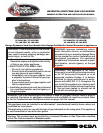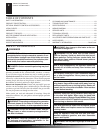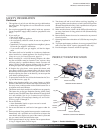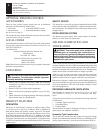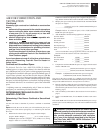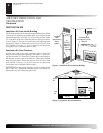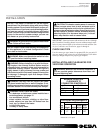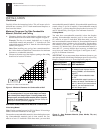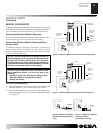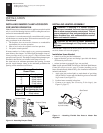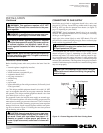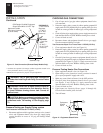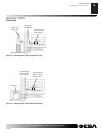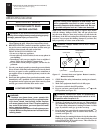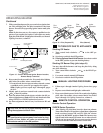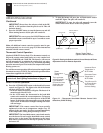
111826-01E
For more information, visit www.desatech.com
5
5
40,000
33,000
73,000
Unusually tight construction is de fi ned as construction
where:
a. walls and ceilings exposed to the outside at mo sphere
have a con tin u ous water vapor retarder with a rating
of one perm (6 x 10
-11
kg per pa-sec-m
2
) or less with
open ings gasketed or sealed and
b. weather stripping has been add ed on openable win-
dows and doors and
c. caulking or sealants are applied to areas such as
joints around window and door frames, be tween sole
plates and fl oors, be tween wall-ceiling joints, be tween
wall panels, at pen e tra tions for plumb ing, electrical,
and gas lines, and at other openings.
If your home meets all of the three criteria above, you
must pro vide ad di tion al fresh air. See Ventilation Air
From Outdoors, page 6.
If your home does not meet all of the three criteria above,
proceed to De ter min ing Fresh-Air Flow For Heater Lo-
ca tion, below.
Confi ned and Unconfi ned Space
The National Fuel Gas Code, ANSI Z223.1/NFPA 54 defi nes a
con fi ned space as a space whose volume is less than 50 cubic feet
per 1,000 Btu per hour (4.8 m
3
per kw) of the ag gre gate input rating
of all ap pli anc es in stalled in that space and an un con fi ned space as
a space whose vol ume is not less than 50 cubic feet per 1,000 Btu
per hour (4.8 m
3
per kw) of the ag gre gate input rating of all appli-
ances in stalled in that space. Rooms com mu ni cat ing di rect ly with
the space in which the ap pli anc es are in stalled*, through openings
not fur nished with doors, are con sid ered a part of the unconfi ned
space.
* Adjoining rooms are communicating only if there are doorless
passageways or ven ti la tion grills between them.
DETERMINING FRESH-AIR FLOW FOR
HEATER LOCATION
Determining if You Have a Confi ned or Unconfi ned
Space
Use this work sheet to determine if you have a confi ned or un con fi ned
space.
Space: Includes the room in which you will install heater plus any ad-
joining rooms with doorless passageways or ventilation grills between
the rooms.
1. Determine the volume of the space (length x width x height).
Length x Width x Height = ____________cu. ft. (vol ume of space)
Example: Space size 20 ft. (length) x 16 ft. (width) x 8 ft. (ceil ing
height) = 2560 cu. ft. (vol ume of space)
AIR FOR COMBUSTION AND
VENTILATION
Continued
WARNING: If the area in which the heater may be
operated is smaller than that defi ned as an un con fi ned
space or if the building is of unusually tight construc-
tion, provide ad e quate com bus tion and ven ti la tion
air by one of the methods described in the National
Fuel Gas Code, ANSI Z223.1/NFPA 54 Sec tion 5.3 or
applicable local codes.
If additional ventilation to adjoining room is supplied with grills or open-
ings, add the volume of these rooms to the total vol ume of the space.
2. Multiply the space volume by 20 to determine the maximum Btu/Hr
the space can support.
____________(volume of space) x 20 = (Maximum Btu/Hr the space
can sup port)
Example: 2560 cu. ft. (volume of space) x 20 = 51,200 (max i mum
Btu/Hr the space can sup port)
3. Add the Btu/Hr of all fuel burning ap pli anc es in the space.
Vent-free heater _____________ Btu/Hr
Gas wa ter heater* _____________ Btu/Hr
Gas fur nace _____________ Btu/Hr
Vented gas heater _____________ Btu/Hr
Gas fi re place logs _____________ Btu/Hr
Other gas appliances* + _____________ Btu/Hr
Total = _____________ Btu/Hr
* Do not include direct-vent gas ap pli anc es. Direct-vent draws com-
bus tion air from the outdoors and vents to the outdoors.
Example:
Gas water heater _____________ Btu/Hr
Vent-free heater + _____________ Btu/Hr
Total = _____________ Btu/Hr
4. Compare the maximum Btu/Hr the space can support with the actual
amount of Btu/Hr used.
____________________Btu/Hr (maximum the space can sup port)
____________________Btu/Hr (actual amount of Btu/Hr used)
Example: 51,200 Btu/Hr (max i mum the space can support)
73,000 Btu/Hr (actual amount of Btu/Hr used)
The space in the above example is a con fi ned space because the actual
Btu/Hr used is more than the maximum Btu/Hr the space can sup port. You
must provide additional fresh air. Your op tions are as follows:
A. Rework worksheet, adding the space of an adjoining room. If the ex tra
space provides an unconfi ned space, remove door to ad join ing room or
add ven ti la tion grills between rooms. See Ven ti la tion Air From Inside
Building, page 6.
B. Vent room directly to the outdoors. See Ventilation Air From Out doors,
page 6.
C. Install a lower Btu/Hr heater, if lower Btu/Hr size makes room un con -
fi ned.
If the actual Btu/Hr used is less than the maximum Btu/Hr the space can sup-
port, the space is an unconfi ned space. You will need no additional fresh air
ven ti la tion.
AIR FOR COMBUSTION AND VENTILATION
Providing Adequate Ventilation (Cont.)
Determining Fresh-Air Flow for Heater Location



